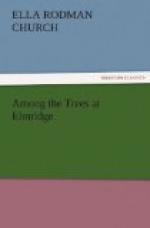“This isn’t a pine tree, is it?” asked Malcolm, touching a small tree with very slender branches, some of them as slight as willow-withes and covered with grayish-red bark, while that on the main stem was bluish gray.
[Illustration: THE LARCH.]
“It is a species of pine,” was the reply, “because it belongs to the Coniferae, or cone-producing, family; but it is not an evergreen, although it ranks as such. This is the larch—generally called in New England by its Indian name of hacmatack—and it differs from the other pines in its crowded tufts of leaves, which, after turning to a soft leather-color, fall, in New England, early in November. The cones, too, are very small.”
“What’s the use of cones, any way?” asked Malcolm as he picked up some very large ones under the white and pitch pines.
“Their principal use,” replied his governess, “is to contain the seeds of future trees: they are the fruit of the pine; but they have a number of uses besides, which you shall hear about this evening.”
“The little cones at Hemlock Lodge are pretty,” said Edith, “and Clara and me play with ’em. We play they’re a orphan-’sylum.”
[Illustration: FOLIAGE OF THE LARCH (Larix Americana).]
“‘Clara and I,’ dear,” corrected Miss Harson, smiling at the “orphan-’sylum,” while Malcolm said he had never thought of that before, and it must be what they were meant for. Edith could not quite understand whether this was fun or earnest, but Miss Harson shook her head at Malcolm and called him “naughty boy.”
“The spruce and hemlock,” continued their governess, “and many of the other evergreens, we have at Elmridge, but I brought you here to-day for our drive that you might examine these magnificent pine trees, and so be better able to understand whatever we can find out about them this evening. Thomas is probably tired of waiting by this time; so we will leave the fragrant pine-woods for the present, and promise ourselves some future visits.”
Every green thing was now in full summer beauty, and daisies and buttercups gemmed the fields, while the garden at Elmridge was all aglow with blossoms, The children remembered their flower-studies of last year, and took fresh pleasure in the woods because of them; but the trees now seemed quite as interesting as the flowers had been.
* * * * *
“The trees known as evergreens,” said Miss Harson, “are not so bright and cheerful-looking as those which are deciduous, or leaf-shedding, but they have the advantage of being clothed with foliage, although of a sober hue, all the year round. They consist of pines, firs, junipers, cypresses, spruces, larches, yews and hemlocks, with some foreign trees, and form a distinct and striking natural group. ’This family has claims to our particular attention from the importance of its products in naval, and especially in civil and domestic, architecture, and in many other arts, and, in some instances, in medicine. Some of the species in this country are of more rapid growth, attain to a larger size and rise to a loftier height than any other trees known. The white pine is much the tallest of our native trees.’”




